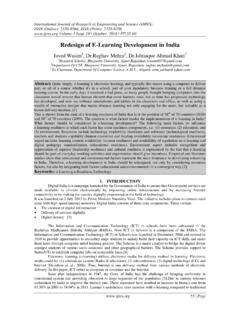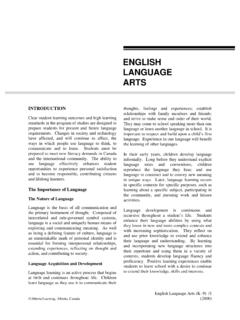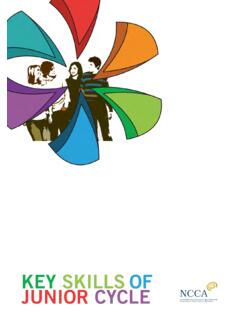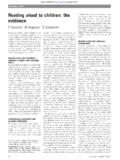Transcription of Implementation guidelines for indicators of preschool ...
1 Implementation guidelines for indicators of preschool numeracy and literacy in government preschools ii Implementation guidelines for indicators of preschool Numeracy and literacy in government preschools Contents What are the expectations of preschool sites? .. 1. How will sites be supported to meet these requirements? .. 2. What are the responsibilities of preschool leaders and teachers? .. 2. How is numeracy and literacy de ned today? .. 3. Why have the indicators been developed? .. 4. What are the indicators of preschool numeracy and literacy ? .. 5. How are the indicators represented? .. 6. The child and the 7. learning processes .. 8. indicators .. 9. Key elements .. 10. How were the indicators developed? .. 11. How do teachers use these indicators ?
2 12. Planning for learning .. 12. Assessment for learning .. 13. Collecting evidence and showing progress .. 14. Reporting .. 15. Published May 2015 Department for Education and Child Development (DECD). Implementation guidelines for indicators of preschool Numeracy and literacy in government preschools iii Summary .. 15. Numeracy chart .. 17. literacy chart .. 18. Examples of practice .. 19. Appendices .. 87. Appendix 1: Glossary .. 88. Appendix 2: References .. 90. Appendix 3: 2014 DECD trial sites .. 92. Appendix 4: DECD Numeracy and literacy Reference Group .. 93. Appendix 5: DECD Numeracy Expert Working Group 2013-2014 .. 95. Appendix 6: DECD literacy Expert Working Group 2013-2015 .. 96. With thanks to Professor Pauline Harris (University of South Australia and Lillian De Lissa Chair), Professor Peter Sullivan (Monash University), Dr Steve Thornton (President of the Association of Mathematics Teachers), the members of the Numeracy and literacy Reference Group and the members of the Numeracy and literacy Expert Working Groups for the expert advice and support they provided in the process of developing the indicators of preschool numeracy and literacy .
3 1 Implementation guidelines for indicators of preschool Numeracy and literacy in government preschools What are the expectations of preschool sites? 2015. All preschool leaders and teachers will become familiar with the indicators of preschool numeracy and literacy (the indicators ) during 2015. Teachers may use the indicators to inform their practice. They are not expected to use the indicators to monitor and report on children's learning and development. 2016. From the beginning of 2016, preschool teachers will be required to use the indicators to inform their planning and teaching, to monitor children's numeracy and literacy development, and to inform the Statement of learning for discussion with and reporting to families. The information will also be used to support the transition of children from preschool to school.
4 Implementation guidelines for indicators of preschool Numeracy and literacy in government preschools 2. How will sites be supported to meet these requirements? Sites will be supported by early years experts from the Office for Education and Office for Children and Young People Preschools will receive two printed copies of the updated indicators during Term 2, 2015. Introductory sessions on the indicators will be provided from Term 2, 2015. Professional learning , resources and support materials will be made available Sites and partnerships will be supported to develop familiarisation and Implementation plans. What are the responsibilities of preschool leaders and teachers? preschool leaders are responsible to the education director for leading the familiarisation process in their preschool during 2015 and for ensuring Implementation of the indicators from 2016.
5 Teachers are responsible to their preschool leader for engaging in the familiarisation process during 2015 and for implementing the indicators from 2016. 3 Implementation guidelines for indicators of preschool Numeracy and literacy in government preschools How is numeracy and literacy de ned today? The national early childhood curriculum Belonging, Being & Becoming: the Early Years learning Framework (EYLF) describes numeracy and literacy as follows: Numeracy is the capacity, confidence and disposition to use mathematics in daily life. Children bring new mathematical understandings through engaging in problem solving. It is essential that the mathematical ideas with which young children interact are relevant and meaningful in the context of their current lives.
6 Spatial sense, structure and pattern, number, measurement, data argumentation, connections and exploring the world mathematically are the powerful mathematical ideas children need to become numerate. (EYLF p. 38). literacy is the capacity, confidence and disposition to use language in all its forms. literacy incorporates a range of modes of communication including music, movement, dance, storytelling, visual arts, media and drama, as well as talking, reading and writing. Contemporary texts include electronic and print-based media. In an increasingly technological world, the ability to critically analyse texts is a key component of literacy . Children benefit from opportunities to explore their world using technologies and to develop confidence in using digital media.
7 (EYLF p. 38). The indicators are underpinned by the principles, practices, and learning outcomes in the Early Years learning Framework. Think about What theories, philosophies and understandings inform your practices about numeracy and literacy learning ? Does your site's de nition of literacy and numeracy re ect the descriptions in the EYLF? Do families see numeracy and literacy in the same way as the teachers? Implementation guidelines for indicators of preschool Numeracy and literacy in government preschools 4. Why have the indicators been developed? The Early Years learning Framework identifies that positive attitudes and competencies in literacy and numeracy are important aspects of communication and are vital for children's successful learning .
8 The foundation for these competencies is built in early childhood. The consultation that took place during the development of the DECD B-18 Numeracy and literacy Strategy (the strategy) identified that parents and families wanted to better understand the numeracy and literacy achievements of their children. It also identified that teachers were seeking greater consistency in assessment and reporting practices. The strategy identifies the need for indicators to support the tracking and monitoring of children's numeracy and literacy development (p. 25). The indicators of preschool numeracy and literacy have been developed for teachers to use in a continuous cycle to identify, plan for, assess, monitor and report on each child's learning and growth.
9 The indicators have been developed to support teachers to extend and enrich every preschool child's numeracy and literacy learning . Specifically, the indicators will assist teachers to: recognise and describe children's numeracy and literacy understandings and learning plan for each child's numeracy and literacy learning monitor and assess each child's numeracy and literacy learning identify children at risk in their numeracy and/or literacy learning share and report on observations of children's numeracy and literacy development reflect on and improve pedagogy for numeracy and literacy learning . 5 Implementation guidelines for indicators of preschool Numeracy and literacy in government preschools What are the indicators of preschool numeracy and literacy ?
10 The indicators recognise that all children come to preschool with numeracy and literacy capabilities, which they demonstrate in their own unique way. They provide significant identifiers of children's numeracy and literacy learning and development at preschool . The indicators : describe how a child sees, interacts with and explores their world identify aspects of numeracy and literacy learning that can be observed in the day to day learning context of a preschool are interconnected and not sequential. The indicators connect with the Australian Curriculum general capabilities continua for numeracy and literacy . The learning continua in the Australian Curriculum describes the knowledge, skills, behaviours and dispositions that students can reasonably be expected to have developed at different stages of schooling.









